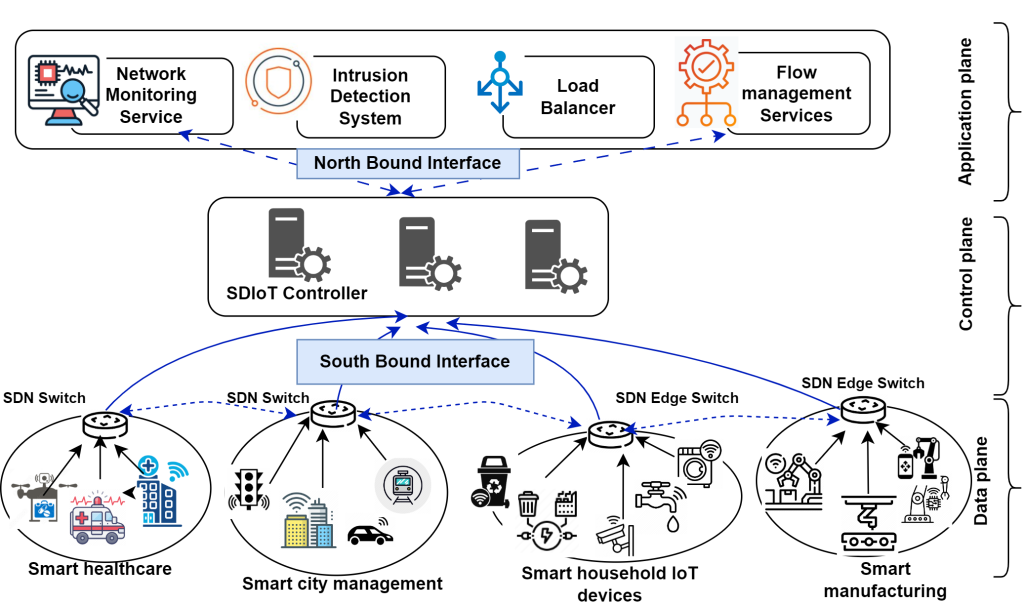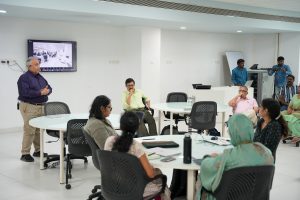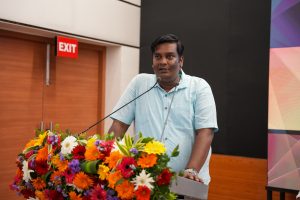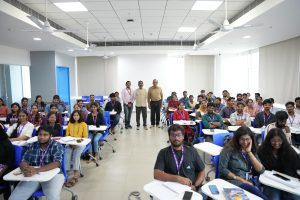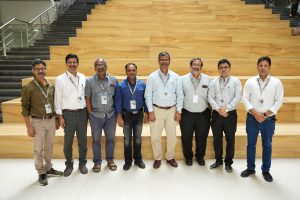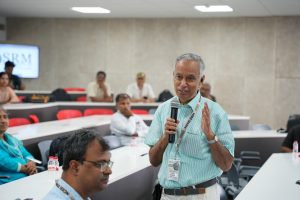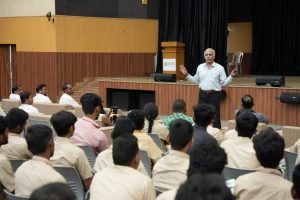A Unified Learning Framework for Detecting Cyberattacks in IoT Networks

The Department of Computer Science and Engineering is proud to announce that Assistant Professors Dr Kshira Sagar Sahoo and Dr Tapas Kumar Mishra, along with their research scholar Ms Arati Behera, have published their paper “A Combination Learning Framework to Uncover Cyberattacks in IoT Networks” in the prestigious Q1 journal Internet of Things, which has an Impact factor of 6.
The article addresses IoT security challenges by utilising Software Defined Networking technology and AI. The authors use Genetic Algorithm to select the most important data features and a hybrid deep learning model combining CNN, Bi-GRU, and Bi-LSTM to detect cyber-attacks effectively. Tested on real-world IoT datasets, the system demonstrates superior accuracy, faster detection, and lower resource usage than existing methods, making it a promising solution for securing resource-constrained IoT networks.
Abstract
This study addresses the security challenges in IoT networks, focusing on resource constraints and vulnerabilities to cyber-attacks. Utilising Software Defined Networking and its adaptability, the authors propose an efficient security framework using a Genetic Algorithm for feature selection and Mutual Information (MI) for feature ranking. A hybrid Deep Neural Network (DNN) combining CNN, Bi-GRU, and Bi-LSTM is developed to detect attacks. Evaluated on InSDN, UNSW-NB15, and CICIoT 2023 datasets, the model outperforms existing methods in accuracy, detection time, MCC, and resource efficiency, demonstrating its potential as a scalable and effective solution for IoT network security.
Practical Implementation/ Social Implications of the Research
The practical implementation of this research lies in enhancing the security of IoT networks, which are increasingly integral to smart homes, healthcare, transportation, and industrial systems. By detecting and mitigating cyber-attacks efficiently, the proposed model can safeguard sensitive data, prevent service disruptions, and ensure the reliability of IoT systems.
Collaborations
This research has been conducted in partnership with Umea University Sweden.
Future Research Plans
There is potential to enhance the Deep Learning approach further to reduce the execution time at the power crunch device. Additionally, federated learning could be investigated as a use case, especially concerning edge devices within typical software-defined IoT networks.
- Published in CSE NEWS, Departmental News, News, Research News
Developing a High Gain Bi-directional Converter to Improve Efficacy in EV Applications

Electronic Vehicles (EVs) are a key element of carbon emission reduction strategies and pivotal to contributing to sustainable development. Operating solely on electrical energy, eliminating the need for petrol or diesel, EVs leave a significantly reduced carbon footprint compared to fossil fuel-powered vehicles. Underscoring the impact of EVs on the environment, advanced research is conducted to improve the efficacy and reliability of EVs.
On this note, a research team from the Department of Electrical and Electronics Engineering – Dr Tarkeshwar Mahto, Dr Somesh Vinayak Tewari, Dr Ramanjaneya Reddy and PhD scholar Ms K Mounika Nagabushanam has published a paper titled “High Gain Bi-directional KY converter for low power EV Applications” in the Q1 journal Energy having an Impact Factor of 9. Their research work focuses on the development of a bi-directional DC-DC converter that can be used in EVs for integration of battery to traction motor.
Abstract
In electric vehicles (EVs), the type of electric motor and converter technology have a significant impact on regulating the operational characteristics of the vehicle. Therefore, in this work, the modified bi-directional KY converter (BKYC) is proposed for EV applications. The main contributions of the proposed converter are high step-up/step-down conversion gain, bi-directional power flow, simplified control structure, continuous current, common ground, low volume, and high efficiency. An inductor on either side of the converter ensures continuous current flow and passive components are arranged to operate in series to offer high step-up/step-down conversion. The charging and discharging operations, steady-state analysis, and design process of the proposed converter are discussed in detail and compared with similar bi-directional converter topologies. Further, the efficiency analysis of the proposed converter is presented, and it was found that the efficacy is 95.51% in the charging operation and 96.52% in the discharging operation. The simulations are carried out using MATLAB/Simulink environment. Further, a prototype of a modified bi-directional KY converter is implemented with a TMS320F28335 processor and validated with theoretical and simulation counterparts.
Explanation of the Research in Layperson’s Terms
Electric vehicles (EVs) are built with traction motors, charging circuits, energy storage devices, and lighting systems. Each runs at a different voltage and has a different power level. Various power electronic converters are used to integrate the individual components of an electric vehicle. An electric vehicle (EV) runs primarily on battery power, which can be obtained from on-board charging or charging stations. The battery has a voltage range of 24 to 48 volts. The traction motor, coupled to a DC link bus with a voltage range of 400V to 600V, needs to receive this energy. Consequently, it is necessary to integrate a power converter to raise the voltage from lower voltage batteries to a higher voltage DC link. Additionally, energy lost during motor running can be used to charge batteries to improve the efficiency of the electric vehicle. Therefore, a separate power electronic converter is required for the power flow from the motor to the battery. The primary output of our study is the development of a bi-directional DC-DC converter that facilitates power flow from the battery to the motor and motor to the battery with the necessary voltage gains while maintaining improved efficiency and low cost.
The main challenges in EV technology are battery deterioration due to frequent charging and discharging and the volume of the power converter. The research team plans –
- To work on the noise reduction methods that are brought on by regeneration action
- To work on various control techniques to keep the DC link voltage of the propulsion system constant
- Published in Departmental News, EEE NEWS, News, Research News
Two-day International Conference on Gender Exploitation Concludes
 The two-day international conference on Breaking the Silence: Interdisciplinary Perspective on Gender Exploitation and Resistance organised under the auspices of SRM University-AP comes to a conclusion.
The two-day international conference on Breaking the Silence: Interdisciplinary Perspective on Gender Exploitation and Resistance organised under the auspices of SRM University-AP comes to a conclusion.
The international conference drew diverse audiences of academicians, academic experts, research scholars and students from across the country and outside, and featured talks by eminent academicians as Prof. Anita Singh, Department of English, Banaras Hindu University, Varanasi; Prof. Rajinder Dudrah, Professor of Cultural Studies and Creative Industries, Birmingham City University; Prof. Geetanjali Gangoli, Department of Sociology, Durham University; Prof. Nalini Iyer, Department of English, Seattle University; Prof. Priyanka Tripathi , Department of Humanities and Social Sciences, Indian Institute of Technology Patna.
The sessions explored themes of gender and resistance, intersectionality, trauma and survival and so on. With 5 guest speakers, over 70 research paper presentations and over 140 participants the conference offered multifaceted perspectives on Gender Exploitation and Resistance.
Prof. Vishnupad, Dean-Easwari School of Liberal Arts in his address stated, “Notwithstanding 60 odd years of feminist movements and scholarship, gender asymmetry and violence, is one of those archives that needs to be continually visited and revisited, because patriarchal forms and gender violence remains as rampant as it always was.” Further, while elaborating on violence, he questioned the easy equation of education with progress and conjectured on the relation of education and violence. The manic obsession in Indian society for engineering and medical degrees and its resulting impact on young school going students, for him, consisted of one such perverse instance; the annual student suicides number in places such as Kota amply instantiate that violence.
Dr Sayantan Thakur, Assistant Professor and Head – Department of Literature and Languages, remarked “Conferences such as these are both inspiring and daunting; while they convene bright minds capable of addressing critical issues, they also depict to us that challenges such as gender exploitation continue to be.”
Prof. Anita Singh from Banaras Hindu University in her keynote address cited several compelling instances wherein women were denied justice, reflecting thereby a troubled pattern of societal indifference.
The discourses in the conference addressed the multifaceted barriers that are posed within the system, compelling one to discuss, debate and deliberate and “break the silence” that surrounds gender exploitation.
- Published in Departmental News, English news, News
A Blockchain and IoT-Driven Solution for Farmers
 Farming is often regarded as an occupation that is challenging and has become a sobriquet for hardship and unpredictability, leaving farmers financially vulnerable and many a times at the brink of poverty. Insuring crops can, however, minimise the risk of loss, making it a viable option as long as the process doesn’t get bogged down by excessive bureaucracy and cumbersome paperwork. Dr Naga Sravanthi Puppala, Assistant Professor at the Department of Computer Science and Engineering has come up with a game-changing solution of utilising blockchain technology and real time IoT data for automatic and quick coverage of crops by simplifying the insurance process thereby helping reshaping the future of agriculture, just when it’s needed most.
Farming is often regarded as an occupation that is challenging and has become a sobriquet for hardship and unpredictability, leaving farmers financially vulnerable and many a times at the brink of poverty. Insuring crops can, however, minimise the risk of loss, making it a viable option as long as the process doesn’t get bogged down by excessive bureaucracy and cumbersome paperwork. Dr Naga Sravanthi Puppala, Assistant Professor at the Department of Computer Science and Engineering has come up with a game-changing solution of utilising blockchain technology and real time IoT data for automatic and quick coverage of crops by simplifying the insurance process thereby helping reshaping the future of agriculture, just when it’s needed most.
Abstract
The invention is a groundbreaking design patent that employs a single, sophisticated smart contract policy to autonomously manage the entire crop insurance process. This system innovatively combines blockchain technology with real-time IoT data collection to create an efficient, transparent, and reliable insurance solution for farmers. Central to this invention is a singular smart contract policy designed to oversee every stage of the insurance lifecycle, from policy issuance and dynamic risk assessment to claims processing and payout disbursement. This smart contract policy is meticulously programmed with specific conditions and thresholds, including weather patterns, soil moisture levels, and crop health indicators, all monitored by IoT devices in the field. As these conditions are tracked in real-time, the smart contract policy autonomously adjusts coverage and triggers payouts when necessary, eliminating the need for human intervention. This system not only enhances efficiency by reducing administrative costs but also ensures prompt and accurate payouts. By relying on tamper-proof data and predefined conditions, the invention offers a secure and transparent approach to crop insurance, providing farmers with a dependable safety net against crop losses.
In short, this invention makes crop insurance smarter, simpler, and fairer, giving farmers the support they need when they need it most.
Practical Implementation and Social Implications of the Research
Practical Implementation
- Blockchain: Secure platform for immutable records.
- Smart Contracts: Automate insurance claims based on predefined triggers.
- IoT Devices: Monitor crop and environmental data in real-time.
- Oracles: Fetch external data (e.g., weather reports).
- Workflow: Farmers enroll, pay premiums digitally, and receive automatic payouts if crop damage is detected.
Social Implications
- Transparency: Eliminates fraud and delays in claims.
- Inclusivity: Provides insurance access to small-scale farmers.
- Economic Stability: Reduces financial strain on farmers after disasters.
- Sustainability: Encourages data-driven, risk-resilient agriculture.
Future Research Plans:
Building upon the foundation of this invention, my future research will focus on advancing and expanding its applications to maximize impact in agriculture and beyond. Key areas of exploration include:
1. Enhancing IoT Integration for Precision Agriculture
Aimed to develop more advanced IoT devices and sensors that can collect highly specific data on soil quality, weather patterns, and crop health. This data will improve the system’s ability to predict risks and tailor insurance policies to individual farms. Research will also involve optimizing sensor networks for affordability and accessibility to smallholder farmers.
2. Developing Dynamic Risk Assessment Models
By incorporating machine learning and predictive analytics, I plan to create dynamic risk assessment models. These models will continuously learn from real-time data and historical trends, allowing the system to provide proactive alerts to farmers about potential risks and automatically adjust insurance terms to reflect current conditions.
3. Expanding Blockchain Applications Beyond Crop Insurance
While the current focus is on crop insurance, blockchain’s secure and transparent nature offers opportunities for broader agricultural applications. I intend to explore its use for supply chain traceability, ensuring that crops reach markets efficiently and without tampering, and for facilitating peer-to-peer lending among farmers.
4. Testing and Scaling in Diverse Agricultural Environments
Field trials will be conducted in various regions and farming contexts to test the system’s adaptability and scalability. This includes:
- Testing in regions prone to extreme weather conditions.
- Evaluating the system’s performance in specialized farming industries, such as vineyards or organic farming.
- Collaborating with agricultural cooperatives to implement the system across multiple farms simultaneously.
5. Social and Economic Impact Assessment
A critical part of my research will involve studying the socioeconomic impact of this invention on farmers, particularly smallholder farmers. I aim to assess how it influences their livelihoods, productivity, and financial security. This will guide future improvements to make the system more inclusive and equitable.
6. Exploring Policy and Regulatory Frameworks
For widespread adoption, I plan to engage with policymakers to align the system with existing agricultural and insurance regulations. The research will focus on creating policy frameworks that encourage adoption, particularly in developing regions and addressing potential legal challenges related to blockchain and data privacy.
7. Collaborating for Multi-Sectoral Impact
Partnerships with financial institutions, agritech companies, and government agencies to co-develop solutions that integrate blockchain-based insurance with other agricultural services, such as microloans, subsidies, and educational programs.
By addressing these areas, my research will contribute to creating a more resilient and sustainable agricultural ecosystem, empowering farmers with cutting-edge technology while enhancing food security and economic stability globally.
- Published in CSE NEWS, Departmental News, News, Research News
Industry 4.0 Readiness: Transforming the Future of Manufacturing
 The Department of Mechanical Engineering concluded its 5-day intense Faculty Development Programme on Smart Manufacturing and Industry 4.0 organised with the objective of highlighting Smart Manufacturing to boost efficiency and sustainability, fostering collaboration among researchers, academicians, and industry experts and improving manufacturing practices and sustainability through innovation.
The Department of Mechanical Engineering concluded its 5-day intense Faculty Development Programme on Smart Manufacturing and Industry 4.0 organised with the objective of highlighting Smart Manufacturing to boost efficiency and sustainability, fostering collaboration among researchers, academicians, and industry experts and improving manufacturing practices and sustainability through innovation.
The FDP kick-started with a plenary lecture on Smart Manufacturing/Industry 4.0, followed by interactive sessions led by eminent speakers. The FDP witnessed industrial and academic stalwarts such as Prof. Ramesh Babu, IIT Chennai; Mr Amit Baddi, Samprama Digitech, Pune; Dr Rishi Relan, Siemens, Delhi; Prof. Kaushal Desai, IIT Jodhpur to name a few. The resource persons, experts in their specific realms, primed over 100+ participants from both in and around the varsity.
The participants had the opportunity to learn about big data analytics and machine-to-machine communication, real-time data collection and processing using IoT, and seamless integration of manufacturing system components. The FDP encouraged extensive discussions and knowledge sharing sessions, bestowing a pivotal opportunity for participants, educators and industry practitioners to immerse themselves in the future of manufacturing.
The FDP also offered the participants significant opportunities to contribute to the evolving manufacturing landscape, ultimately enhancing productivity, efficiency, and sustainability in their respective fields. Academic colloquiums such as these prove to be significant in readying the next cohort of engineers and technology enthusiasts to tackle the problems of tomorrow.




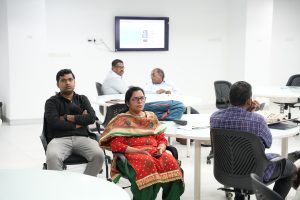





- Published in Departmental News, FDP, Mechanical Engineering NEWS, News
Student-Teacher Collaboration Culminates in IEEE Transactions
 The increasing demand for sustainable energy solutions has led to the development of hybrid energy systems that integrate renewable sources like solar photovoltaic (PV) systems and fuel cells (FC). The practical applications of the research in sectors such as electric vehicles and residential power systems, contribute to a more reliable and sustainable energy future contributing to a more reliable and sustainable future.
The increasing demand for sustainable energy solutions has led to the development of hybrid energy systems that integrate renewable sources like solar photovoltaic (PV) systems and fuel cells (FC). The practical applications of the research in sectors such as electric vehicles and residential power systems, contribute to a more reliable and sustainable energy future contributing to a more reliable and sustainable future.
Abstract of the research.
This paper introduces novel high-gain tertiary port boost converter (HGTPBC) designed for hybrid energy sources such as solar photovoltaic (PV) and fuel cells (FC). The converter is employed with dual input sources by facilitating modular converters and accomplishes a high step-up voltage gain by virtue of a voltage multiplier in a DC microgrid, where the prosumers can have an islanded operation. The proposed topology allows home appliances to be powered by multiple energy source without the need for a large storage unit. Key features include continuous input current, reduced normalized voltage stress on switches, expandability for multiple input sources and independent source control. The independent control facilitates the standalone operation with single source during source failure or absence. To evaluate the converter performance, a thorough steady-state analysis, both with and without consideration of nonidealities is carried out. Detailed comparisons with existing converter topologies highlight the advantages of the proposed converter. Moreover, the loss distribution and efficiency analysis of proposed converter are presented and found to be 91.59% efficiency at rated power. Theoretical aspects are validated through hardware testing on a 100W laboratory prototype.
Explanation of the Research in layperson’s terms.
The proposed converter is a 100W DC-DC converter topology used in hybrid energy systems applications and electric vehicular applications in DC microgrid. The converter can accept two sources like fuel cell and solar PV system to supply the load and even can be extended for a greater number of sources. Thus, it is suitable for various applications of traction vehicles, household electrifications etc. It exhibits a lower switch stress and higher step-up conversion gain.
Practical Implementation and Social implications
The features include high step-up conversion gain, independent control possible, reduced normalised switch voltage stress. And flexible operation based on PV availability. It is most suitable for electric vehicles, Unmanned ariel vehicles, and hybrid energy systems etc. It improves the reliability of the renewable energy source by the incorporation of the second fixed source, fuel cell. It can be used in various on-grid and off-grid applications like home, hospitals, offices, and educational institutions, especially where source reliability is necessary. The major advantage is the reduction in the size of the source due to higher step-up gain and ease of control between the sources.
Future Research Plans
We are working towards the development of efficient and ultra-high gain bidirectional converters for various applications on DC microgrids. That should be able of reducing the source ratings and to integrate multiple sources to improve the grid reliability. Design and implementation of bidirectional multi-port converters for various applications of DC microgrids, such as renewable and hybrid storage integration are the scope of our research.
The link to the article- https://ieeexplore.ieee.org/document/10772206

- Published in Departmental News, EEE NEWS, News, Research News
Promoting Financial Literacy with NISM

In a major initiative to promote financial literacy, the Paari School of Business organised a full-fledged Financial Education Programme under the Kona Kona Shiksha CSR Project, conducted by the National Institute of Securities Markets (NISM), on November 23 – 24 and 27 – 28, 2024. Mr Chilkuri Vijay Kumar, an NISM-empanelled resource person, conducted the programme, which saw enthusiastic participation from more than 140 MBA students.
The 10-hour programme covered, among the most important themes, career opportunities within the securities market, some investment fundamentals, primary and secondary markets, mutual funds, and various investor protection mechanisms. Besides lectures, dynamic discussions were conducted with insight into current happenings to introduce participants to the world of financial planning and investment strategies.
Mr Vijay Kumar’s interactive sessions helped students gain deeper insights into the securities market and clarified their understanding of the risks and opportunities of investment. Distributing e-certificates and comprehensive reading materials added value to the learning experience.
The session has set the stage for creating financially informed and responsible citizens. This has further reinforced Paari School of Business’s commitment to providing industry-relevant education and helping its students achieve professional excellence.
- Published in Departmental News, News, Paari Current Happenings, paari-events
SRM AP Hosted the 7th National Conference on Electronic Structure

The 7th National Conference on Electronic Structure successfully concluded at SRM University-AP on November 21 – 23, 2024, under the aegis of the Department of Physics and the Centre for Computational and Integrative Sciences. The conference provided a dynamic platform for discussions and interactions on the recent advances in electron spectroscopy, microscopy, and related theoretical approaches to understanding the electronic structure of materials.
NCES was also aimed at capacity building in the field of electronic structure. Scientists, researchers, and scholars from universities and research institutes assembled to delve deep into research on electronic structure-related projects and works. Scientific discussions and invited lectures showcased insightful sessions by domain experts from India.
Out of forty poster participants, four poster winners were awarded a certificate of appreciation and Rs.3000/—each in recognition of their effort and dedication, contributing to their success.
Prof. Ranjit Thapa (Convenor), Prof. Kalobaran Maiti (National Convenor), and Prof. B R Sekhar (National Convenor) spoke about the significance of the event, which helped scholars know the importance of the NCES event in terms of fruitful scientific interactions and collaborations with each other.
The participants were also on a short tour around Undavalli caves and Kanak Durga Temple. The tour plan facilitated an informal platform for participants to communicate freely and network with others for long-term collaborations.
The 7th National Conference on Electronic Structure was an inspiring experience for all participants, encouraging research scholars to work in the field of electronic structure. The conference also facilitated a conducive environment for problem-solving and innovation.
- Published in Departmental News, News, Physics News, Research Events
Inspiring Future Chemists at ChemZeal 3
 On November 30, 2024, the Department of Chemistry, in collaboration with the Directorate of Admissions, hosted ChemZeal 3, a flagship event that showcased the ever-expanding scope of chemistry in today’s world. The event was graced by prominent personalities, including the Chief Guest, Prof. Vijayamohanan Pillai, Dean of Research & Development at IISER Tirupati, and Dr Veerababu, Director of Cathode, GODI India Pvt. Ltd., Hyderabad, who served as the resource person.
On November 30, 2024, the Department of Chemistry, in collaboration with the Directorate of Admissions, hosted ChemZeal 3, a flagship event that showcased the ever-expanding scope of chemistry in today’s world. The event was graced by prominent personalities, including the Chief Guest, Prof. Vijayamohanan Pillai, Dean of Research & Development at IISER Tirupati, and Dr Veerababu, Director of Cathode, GODI India Pvt. Ltd., Hyderabad, who served as the resource person.
The event began with a welcome address by the convener, Dr Satheesh Ellipilli, who provided an insightful overview of the programme and reflected on the immense success of the previous editions, ChemZeal 1 and 2. He expressed excitement about the growth of the event and its contribution to advancing the knowledge and application of chemistry in various fields.
Following the welcome, the Head of the Department of Chemistry delivered an inspiring speech, offering a comprehensive overview of the department. Dr Pardha Saradhi Maram, Associate Professor and Head highlighted the department’s commitment to academic excellence, research innovation, and fostering an environment where students can explore the transformative power of chemistry.
One of the major highlights of the event was the launch of the “Post a Q” portal by Vice Chancellor, Prof. Manoj K Arora. The portal aims to provide a platform for students and researchers to ask questions and seek solutions in the realm of chemistry. During the launch, Prof. Arora remarked, “Chemistry is such a wonderful science that, no matter what you think of, you will find chemistry in it.” This statement underscored the far-reaching impact of chemistry on everyday life and innovation.
The keynote address by the Chief Guest, Prof. Vijayamohanan Pillai, focused on generating and storing clean energy. He discussed the pivotal role that chemistry plays in developing sustainable solutions for energy storage and generation, from battery technologies to renewable energy sources. Prof. Pillai’s talk resonated with the audience, particularly in the context of the growing need for clean energy in the face of global environmental challenges.
The resource person, Dr Veerababu, shared valuable insights into cathode materials and their applications in the energy sector. His expertise in battery technology and his role at GODI India added depth to the discussions, providing students and faculty with a practical perspective on the industry’s current advancements.
ChemZeal 3 successfully fostered a spirit of collaboration and intellectual curiosity, highlighting the dynamic nature of chemistry and its potential to address some of the world’s most pressing issues. The event concluded with a vote of thanks, acknowledging the contributions of all the speakers, participants, and organisers who made the day a resounding success.
- Published in Chemistry-news, Departmental News, News
Research on Vehicle Density Detection Granted a Patent
 Research Scholars Chetan Mylapilli, Jethin Sai Chilukuri, Rohith Kumar Akula, Sana Fathima, and Assistant Professor Dr Anirban Ghosh from the Department of Electronics and Communication Engineering at SRM University-AP have co-authored an innovative paper titled “A System and Method for Detecting Density-Based Intelligent Parallel Traffic.” This pioneering research delves into the development of an intelligent traffic control system that dynamically adjusts traffic signals based on real-time vehicle density analysis, their research with the patent no- 202241044904 represents a significant step in integrating technology with transportation efficiency.
Research Scholars Chetan Mylapilli, Jethin Sai Chilukuri, Rohith Kumar Akula, Sana Fathima, and Assistant Professor Dr Anirban Ghosh from the Department of Electronics and Communication Engineering at SRM University-AP have co-authored an innovative paper titled “A System and Method for Detecting Density-Based Intelligent Parallel Traffic.” This pioneering research delves into the development of an intelligent traffic control system that dynamically adjusts traffic signals based on real-time vehicle density analysis, their research with the patent no- 202241044904 represents a significant step in integrating technology with transportation efficiency.
Abstract
This work presents an intelligent traffic control system that addresses the gaps in the current state-of-the-art by using a novel hardware-software integration. The system evaluates traffic density in each lane direction and dynamically adjusts traffic lights using a computational algorithm to significantly reduce waiting times at junctions. It also ensures safe pedestrian movement and enables parallel traffic flows. A Raspberry Pi serves as the system’s control unit, utilizing video processing to determine traffic density, while LEDs simulate the traffic lights. The system integrates various hardware and software components, including Raspberry Pi, LEDs, relay modules, VNC software, and sample traffic videos, to provide an efficient solution to the traffic management problem.
Explanation of Research in Layperson’s Terms
The current system uses a Raspberry Pi to control traffic lights based on real-time video of cars at intersections. It detects how many vehicles are in each lane and adjusts the lights to reduce waiting time. Pedestrian safety is managed by ensuring safe crossing times. LED lights simulate the traffic signals, and the system allows smoother traffic flow by handling vehicles moving in parallel. However, it can’t yet control turning vehicles or prioritize emergency vehicles.
Practical Implementation of the Research
The intelligent traffic control system significantly reduces congestion by dynamically adjusting traffic signals, leading to shorter wait times and smoother commutes. It helps lower pollution and fuel consumption by minimizing idle time at junctions, contributing to better air quality and conservation of resources. Pedestrian safety is improved through designated crossing times, reducing accidents. The system also supports economic growth by cutting time wasted in traffic, enhancing productivity.
Future Research Plans
Future research will focus on adding control for turning traffic and distinguishing between different vehicle types to enable emergency vehicle priority. To improve real-time video processing, the system will transition from Raspberry Pi to more efficient hardware like FPGAs or GPUs. Machine learning will be explored for better vehicle detection and traffic signal optimization. Integration with V2X communication will enhance traffic management, and real-world scalability will be tested for deployment in smart city environments.
The prototype:
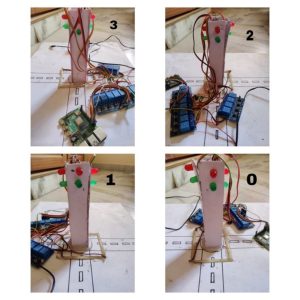
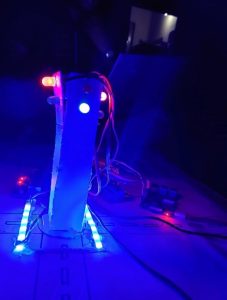

Figure 1. Image of the prototype
Figure 2. Working prototype
Figure 3. Block Diagram of the prototype
- Published in Departmental News, ECE NEWS, News, Research News



